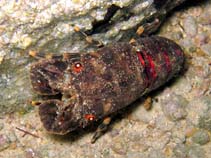Scyllarus arctus (Linnaeus, 1758)
Small European locust lobster| Native range | All suitable habitat | Point map | Year 2050 |

|
| This map was computer-generated and has not yet been reviewed. |
| Scyllarus arctus AquaMaps Data sources: GBIF OBIS |
Classification / Names Common names | Synonyms | CoL | ITIS | WoRMS
Malacostraca | Decapoda | Scyllaridae
Environment: milieu / climate zone / depth range / distribution range Ecology
Benthic; depth range 0 - 444 m (Ref. 101469), usually 4 - 50 m (Ref. 4). Subtropical; 52°N - 10°N, 33°W - 37°E (Ref. 4)
Distribution Countries | FAO areas | Ecosystems | Occurrences | Introductions
Eastern Atlantic and the Mediterranean: Off Madeira, the Canary Islands and along the Atlantic coast of Morocco as far south as Agadir; the Azores, throughout the Mediterranean (but not in the Black Sea) and along the Atlantic coast of Europe to the English Channel.
Length at first maturity / Size / Weight / Age
Maturity: Lm ? range ? - ? cm Max length : 16.0 cm BL male/unsexed; (Ref. 4); common length : 10.0 cm BL male/unsexed; (Ref. 4)
Short description Morphology
Carapace with 3 distinct acute teeth in the median line before the cervical groove (the gastric, pregastric and rostral teeth). Region between the postrostral and branchial carinae with only a few tubercles, and with extensive smooth areas. Abdomen without a sharp median ridge, but each of somites 2 to 5 with an elongate lobulate figure in the middle. The exposed part of somites 2 to 5 with an arborescent arrangement of very narrow grooves. Somite 1 with a complete transverse groove, behind which there are numerous short longitudinal grooves that are rather irregular in shape, may divide and sometimes are interconnected by transverse grooves; this posterior half of somite 1 of equal length throughout its width, not longer in the middle that at the sides. The smooth anterior half of the abdominal somites 2 to 6 (i.e. the part of the somite that disappears under the previous somite when the abdomen is fully stretched) without any indication of grooves or rows of hairs. Fourth segment of antenna with a single oblique median carina. Outer margin of the segment with 2 teeth, the inner margin with 3 or 4 (not including the apical tooth). Thoracic sternum anteriorly V-shapedly incised in the middle. A blunt and low median tubercle on the last thoracic sternite; this tubercle somewhat flattened posteriorly. Dactyli of legs without fringes of hair. Color: Reddish brown with a dark brown pubescence; A dark brown, not sharply delimited spot in the center part of the abdominal somite 1; Segments of the pereiopods with a dark blue band each.
Life cycle and mating behavior Maturity | Reproduction | Spawning | Eggs | Fecundity | Larvae
Ovigerous females from February to April.
Main reference
References | Coordinator | Collaborators
Holthuis, L.B. 1991. (Ref. 4)
IUCN Red List Status (Ref. 130435: Version 2024-1)
Least Concern (LC) ; Date assessed: 03 December 2009
CITES status (Ref. 108899)
Not Evaluated
CMS (Ref. 116361)
Not Evaluated
Threat to humans
Human uses
Fisheries: minor commercial
| FishSource | Sea Around Us
Tools
More information
Trophic Ecology
Ecology
Population dynamics
Growth
Age/Size
Length-weight
Length-length
Length-frequencies
Mass conversion
Recruitment
Abundance
Age/Size
Length-weight
Length-length
Length-frequencies
Mass conversion
Recruitment
Abundance
Life cycle
Distribution
Human Related
Aquaculture profile
Stamps, Coins Misc.
Stamps, Coins Misc.
Outreach
References
Internet sources
BHL | BOLD Systems | CISTI | DiscoverLife | FAO(Publication : search) | Fishipedia | GenBank (genome, nucleotide) | GloBI | Gomexsi | Google Books | Google Scholar | Google | PubMed | Tree of Life | Wikipedia (Go, Search) | Zoological Record
Estimates based on models
Preferred temperature
(Ref. 115969): 14.4 - 21.4, mean 18.3 (based on 298 cells).



